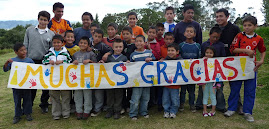 |
| The barbecue before painting. |
The prep work for this project included finding high temperature paint for the job. Many paint stores that I tried in Bogotá carry aerosol cans of this paint, but it is rather expensive in this form, about $12 per can. So I dedicated most of a morning to go find high temp paint in bulk, and when I found it, bought a quart plus the special solvent for about $15. Now I'll know where to go when and if we get around to building those wood stoves that I've been talking about for years....
The next piece of preparatory work involved removing the considerable amount of rust, scale, and grease that has built up on the barbecue over the past couple of months. The boys started on this job using one of the 4-1/2" grinders fitted with a wire wheel, but we quickly found out that this was a job too risky for them to handle. Camilo Castro, one of the older and stronger boys, hit an edge wrong with the grinder, such that he lost control of the grinder and it ended up stalled with the wire wheel wound up in his sweatshirt. Fortunately, he wasn't hurt and I was able to disconnect the cord fairly quickly. I thought the grinder had toasted the motor when it was stalled with the power still on, but after having it checked out at the local dealer, it was deemed still have another life left in it.
So the boys used wire brushes, putty knives, compressed air, and solvent to clean up the body and legs of the barbecue. Then I finished the job using the grinder and wire wheel, but with care, and without incident.
After an afternoon of preparation, it was time to paint. I sprayed the first coat because the boys were all busy with other duties that day.
 |
| The barbecue after the first coat of paint. |
 |
| Andres hadn't used the gun much before this job, so he learned a good deal about how to adjust the gun for each situation, and improved his technique dramatically. |
 |
| We suspended the unit on some lengths of small angle iron for painting the underside, which meant Andres had to stand on a bench to reach the bottom of the supports. |
 |
| Andres ended up with a few wrinkles and runs - but for his level of experience with the gun, he did very well. |
Here's the proof, the finished BBQ, now situated in its own covered spot below the park structure at Granja Peniel, ready for the next time we need to grill some steaks....










